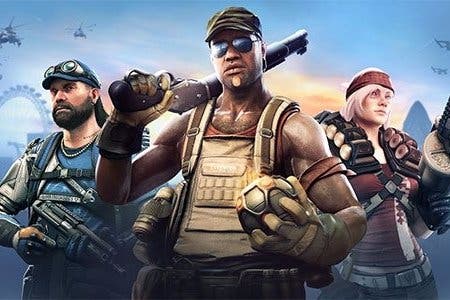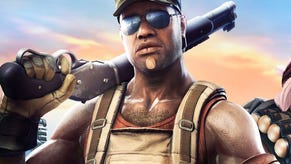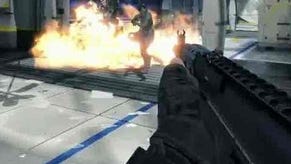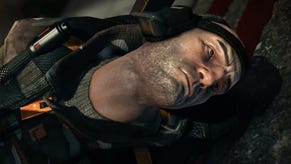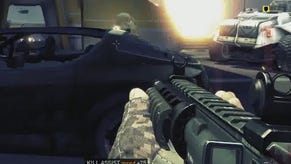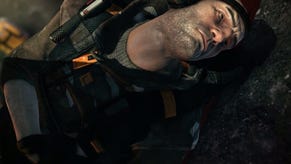Dirty Bomb is armed and dangerous, but is it likely to go nuclear?
Failsafe.
2011's Brink was supposed to be Splash Damage's magnum opus. Stepping away from their lauded Enemy Territory series, Brink was a radical new title bursting with ideas. SMART movement! Context-sensitive objectives! Dynamic maps! Multiplayer narrative! It was a tantalising prospect. Yet for all its ambition, Brink proved a misfire, simply because it wasn't much fun to play. It was too slow, too lightweight, and its map design seemed to funnel players into irresolvable battles of attrition that rendered many of its ideas impotent.
So its unsurprising that, from what we saw in the recently run closed beta, Dirty Bomb is Brink's polar opposite. Well, perhaps that's overstating it. It's not a dizzyingly complex grand strategy or an existentialist pixel-platformer. It's another team-based shooter, and there's only so much possible variation within a genre. Yet whereas Brink's emphasis was innovation, Dirty Bomb sticks to what it knows. Instead it's all about providing a multiplayer FPS that feels as good as is humanly possible. Having spent a few whirlwind evenings in its company, I'm pleased to say that things look promising.
Dirty Bomb pits two teams of five players against each other in a series of objective based maps, all of which are set in a near-future London that has been evacuated after an unspecified disaster (Boris Johnson, renegade bankers, unmitigated hubris, take your pick). Now Britain's capital plays home to several private military companies all fighting one another as they plunder the abandoned city. Presumably in the expansion pack, Glasgow explodes from a collective overload of schadenfreude.
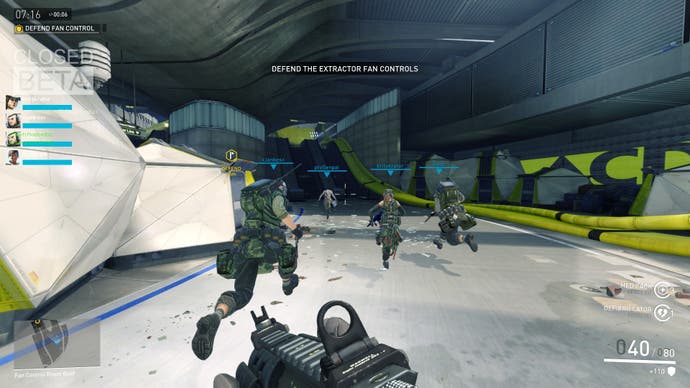
Arbitrary tribalism aside, my initial reaction to Dirty Bomb was one of concern. The art-style, while pleasingly chunky and undoubtedly colourful, somehow manages to be oddly bland. The emphasis placed on the "unique" nature of the game's mercenaries seems particularly misguided. Although each gun-for-hire differs in terms of race, gender, class, loadout and country of origin, none of these traits amount to recognisable characters as they do in Team Fortress 2. They're all shades of chest-beating, wisecracking thug. Nobody is going to remember "Sawbonez" the Medic as they do Team Fortress 2's Teutonic quack. Tonally Dirty Bomb positions itself rather awkwardly between realism and cartoonish excess, and whatever Splash Damage are aiming to do here, at the moment it doesn't entirely succeed.
Fortunately, these issues fade into the background once a game of Dirty Bomb begins in earnest. Within a few minutes of play, memories of Brink's sluggish, awkward controls are banished. Dirty Bomb is slicker than a greased-up seal wearing sunglasses and flipping a coin. Every character is remarkably quick and nimble. Even the machine gun toting heavy moves at a speed that would make Usain Bolt hang up his running shorts. While the combat doesn't have the fire and thunder of Battlefield, it is enjoyably snappy. Weapons kick like a pneumatic horse and abilities are highly responsive. Airstrikes rain down within moments of locking in the target, while grenades can be cooked with microwave speed.
As I delved deeper into Dirty Bomb's wiring, the reasoning behind its aesthetic choices became clear. The fluorescent yellow decontamination pipelines of the map "Underground" stand out from the azure background, tracing the path you need to take through the tunnels. Meanwhile, the beefy architecture of maps like Terminal and Chapel make identifying landmarks easy, vital when navigating at Dirty Bomb's blistering pace. Like so much else in Dirty Bomb, the art is much more pragmatic than conceptual. It enables you to focus on more important things, namely what you're doing, and who you're doing it with.
Each of Dirty Bomb's maps is built around a specific series of objectives. These can be played either as a single round, with one team attacking and the other defending, or with both teams taking turns in "Stopwatch", where one team establishes a time to complete the objective, and the other has to beat it. Chapel, for example, sees the attackers escorting an armoured vehicle through London's streets in order to deliver an EMP device to a nearby building. The defenders must disable the vehicle and prevent the attackers from repairing it. This creates a pleasing ebb and flow of momentum between both teams. One moment the attackers are pushing inexorably forward. Then the car breaks down in an exposed area, and they suddenly need to arrange an ad-hoc defence as the opposing force piles on the pressure.

The two other available maps were structurally more rigid, but still found ways of avoiding bottlenecks and adjusting the emphasis of the conflict. Underground includes several secondary objectives which alter the shape of the map and lend one team an edge. If the attackers started a generator located at the top of an escalator, it would close the ticket barriers near the defenders' spawn, forcing them to take a longer route to the objective they needed to defend. Importantly though, this situation could be reversed if the defenders disabled the generator using C4. Even this isn't the end of the story, as the C4 could then be defused by the attackers.
It's through these layers of tactical possibilities, the subtle shifts in battle focus, that Dirty Bomb's depth begins to emerge. This is equally visible in the design of classes and the need for teamwork. The assault class comes equipped with the aforementioned airstrike ability that can be used to provide much needed defensive support, or obliterate a defending team camping on a chokepoint. They can also carry ammo packs that can be placed on the ground so other players can resupply. Medics can do the same with medpacks, and can also revive fallen players instantaneously using their defibrillators (all players can revive teammates, but it takes time to do so). In addition, Dirty Bomb lets you take up to three mercenaries into battle, and quickly switch between them with the press of a hotkey.
Aside from some inconsistent matchmaking and a few minor balancing issues, which are precisely what a closed beta exists for, I saw little that was fundamentally wrong with Dirty Bomb. The only thing that might be a problem is the lack of a specific hook. For all that it does well, it can't be denied that Splash Damage are treading familiar ground in comfortable slippers. I do wonder how it will fare when sandwiched between multiplayer behemoths like Counter Strike and TF2, and more adventurous games such as Titanfall and Evolve.
Then again, Titanfall's spectacular gimmickry was short-lived, and Evolve looks as if it might go the same way. So perhaps Dirty Bomb's focus on tactility, pace and pragmatism is the right call. Moreover, there may be further tricks up its sleeve that it is yet to reveal. Either way, Dirty Bomb's plutonium core is primed. Now we just need to know how Splash Damage intend to deliver their payload.
